
From the Deputy Assistant Secretary

Welcome to the new format and branding for our newsletter! We are now the OESE Newsflash: PK-12 Grantee News. After starting the newsletter in February 2020 and receiving feedback from the field, we revisited our branding to be more descriptive of what you will learn in our monthly newsletter. We hope you like it as much as we do. As always, please share your feedback with us by emailing OESENewsletter@ed.gov.
This month’s newsletter is focused on accelerated learning. It’s an important topic, given the challenges for many students over the last 18 months, but specifically those with barriers to participation in remote or in person learning, or with social and emotional challenges. We highlight some resources to help you advance accelerated learning in your school system. One resource is the Department’s Return to School Roadmap. Landmark 3 of the Roadmap focuses on accelerating academic achievement and provides related resources, including the newly released guidance on Strategies for Using American Rescue Plan Funding to Address the Impact of Lost Instructional Time. Also, there is a section in the ED COVID-19 Handbook, Volume 2: Roadmap to Reopening Safely and Meeting All Students’ Needs that addresses accelerated learning through instruction, tutoring, and expanded learning time.
We have also highlighted several important resources from the Centers for Disease Control and Prevention (CDC). The guidance enumerates CDC’s list of best practices to prevent transmission of COVID-19, including emphasizing the importance of vaccinating as many eligible children as possible. The CDC also notes that it is critically important to consider the health and well-being of students and staff and to address issues with COVID-19, mental and physical health, and managing other chronic health conditions. As we all know, healthy students are better learners.
As always, thank you for your committed efforts to educate and support our children and to support school staff and families.
Ruth Ryder
|

Featured Technical Assistance: The Regional Educational Laboratory Program
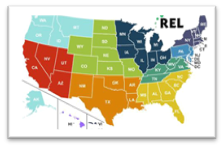
The Institute of Education Sciences’ ten Regional Educational Laboratories (RELs) work in partnership with school districts, state departments of education, and other education stakeholders to use data and research to improve academic outcomes for students. For more than 50 years, the RELs have worked in collaboration with these stakeholders to support them in generating and using evidence to improve student outcomes.
Over the past 18 months, the RELs and the What Works Clearinghouse (WWC) accelerated the pace at which they developed evidence-based resources to support student learning. Although some resources are particularly relevant to COVID-19, including guidance about teaching and learning in a remote environment, most are broadly applicable to the work of states, districts, and individual educators. Additionally, some products are designed especially for parents and caregivers.
Examples include:
|

Meet Department Staff Member Dr. Matthew Soldner
Meet Dr. Matthew Soldner, Commissioner of the National Center for Education Evaluation and Regional Assistance and the Department’s Chief Evaluation Officer, who works at the Institute of Education Sciences.
How long have you been at the Department?
- Most recently, I’ve been at the Department since July 2018; it’s hard to believe that it’s been three years! But this is actually my second time at both the Department and its Institute of Education Sciences. I began my career in government in our National Center for Education Statistics, where I focused on work related to postsecondary access and completion.
What do you most enjoy about working at the Department?
- I wear a few hats at the Department, but each of them shares a common purpose: helping to discover “what works” in service of supporting every learner achieving their goals — and then making sure those discoveries actually get used in policy and practice. There’s no greater privilege! If that weren’t enjoyable enough, I’m lucky to work with a truly wonderful group of colleagues. This includes a wonderful team inside the Institute of Education Sciences as well as people across the Department who I work with day in, day out to help achieve our mission.
What is one thing you would like to see happen as a result of OESE’s collective efforts this year?
- In January 2022, we will start a new five-year cycle of the REL program. This is an exciting time, in which RELs will work with state and local stakeholders across the region to identify new opportunities for collaboration that have the potential to “move the needle” for our nation’s students. My hope is that they do just that, ultimately benefitting the students and communities they are meant to serve.
|

Centers for Disease Control and Prevention Updates
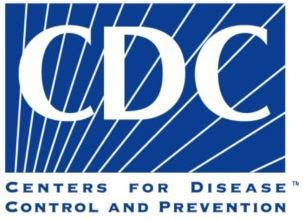
Updated Guidance for COVID-19 Prevention in K-12 Schools
The Centers for Disease Control and Prevention (CDC) has issued updated guidance for COVID-19 prevention in K-12 schools, emphasizing the importance of vaccinating as many eligible children as possible. The guidance also enumerates the CDC’s list of best practices to prevent transmission of COVID-19. For children too young to get a vaccination, the CDC recommends multiple strategies to reduce the risk of transmission, including mask wearing for ages 2 and up and, when possible, physical distancing of at least three feet in indoor school settings. Additional protective measures include frequent handwashing and good indoor ventilation and cleaning procedures. The CDC urges any students or staff with signs of illness to stay home, be tested for COVID-19, and quarantine if indicated. The guidelines prioritize in-school instruction and stress the need to remain flexible on educational settings. This guidance is intended to supplement state and local health and safety laws and regulations and should be adopted and implemented in collaboration with state and local public health agencies. The following is additional guidance and information: CDC Offers Health Tips for Back to School During COVID-19, School Testing for COVID-19, and Tribal Communities.
Lessons from the Field: Strategies for Safely Returning to School - The Latest Federal Guidance
This webinar by OESE’s Office of Safe and Supportive Schools and the National Center on Safe Supportive Learning Environments features updates from CDC and the Department of Education on preparing to return to school for the 2021-22 school year. Following the federal agency updates, CDC and Department staff address practitioner questions to help field personnel to better understand and ultimately operationalize guidance. Visit this page to access the webinar materials.
|

Technical Assistance Resources: Accelerated Learning

Return to School Roadmap
On Aug. 2, the Department released the “Return to School Roadmap,” a resource to support students, schools, educators, and communities as they prepare to return to safe, healthy in-person learning this fall and emerge from the pandemic stronger than before. The Roadmap provides key resources and supports for students, parents, educators, and school communities to build excitement about returning to classrooms this school year and outlines how federal funding can support the safe and sustained return to in-person learning. As part of the Roadmap launch, the Department released:
- A fact sheet for schools, families, and communities on the Return to School Roadmap, reviewing the three “Landmark” priorities and highlighting schools and districts that are addressing each in effective ways.
- A guide for schools and districts outlining what schools can do to protect the health and safety of students, including increasing access to vaccinations and steps for implementing the CDC’s recently updated K-12 school guidance.
- A checklist that parents can use to prepare themselves and their children for a safe return to in-person learning this fall, leading with vaccinating eligible children and masking up if students are not yet vaccinated.
Please visit this page for additional information on the Roadmap, including the Department’s plans to provide additional resources to schools, districts, parents, and students in the coming weeks.
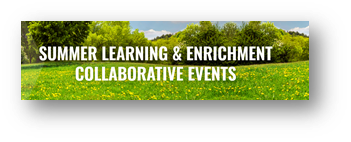
Summer Learning & Enrichment Collaborative
The Summer Learning & Enrichment Collaborative, sponsored by the National Comprehensive Center in partnership with the Department and national partners, concluded summer sessions last month with an opportunity to reflect on how we can continue to reimagine what is possible in creating safe, supportive, and exciting spaces for students to learn and thrive as students return to school. Visit the events archive webpage to view recordings, resources, and practical advice on topics such as leveraging federal funds to expand summer programming, capitalizing on partnerships to maximize learning opportunities for children, supporting students’ social and emotional well-being, and applying evidence-based practices to local program design.
|
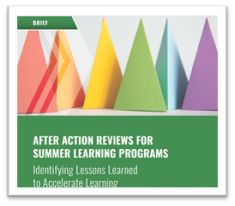
After Action Reviews for Summer Learning Programs
This guide by the National Comprehensive Center gives users the steps and content to conduct an after action review (AAR) about summer learning programs. An AAR can assist schools and districts to identify the lessons learned from previous summer and extended learning programs, as well as from current attempts at providing hybrid and remote learning. These lessons can inform strategies for learning recovery to implement during the school year and subsequent summers.
|
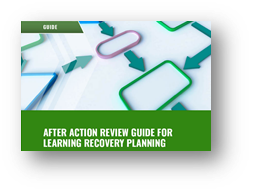
After Action Review Guide for Learning Recovery Planning
This guide by the National Comprehensive Center instructs users on how to hold an after action review on learning recovery programming. After action reviews can help schools and districts identify lessons learned from previous learning and enrichment programs, including current efforts to provide hybrid and remote learning options. These reviews can inform learning recovery strategies throughout the school year to accelerate learning and to support students’ social, emotional, and mental health.
|

Education Stories From the Field Phase 2: Maintaining Education Quality Across Pandemic Schooling Models
This Education Stories From the Field webpage by the National Comprehensive Center includes a series of in-depth interviews with state education leaders in Missouri, New Mexico, Pennsylvania, and Wyoming that document the experience of managing the COVID-19 pandemic response at a state level. In this blog post, the National Comprehensive Center checks back in with these state chiefs to learn about their decision-making processes, the lessons they learned, and the challenges they encountered as they led their states through the first six months of the 2020-2021 school year. During this time, these leaders developed the processes that would transition their institutions from emergency remote instruction to new modalities of full-time virtual, in-person, or hybrid teaching and learning.
|

![]()
About the Author
Ruth Ryder is the Deputy Assistant Secretary for the Office of Office of State Grant and Program Support in the Office of Elementary and Secondary Education (OESE) at the U.S. Department of Education. In this role, Ms. Ryder oversees a broad range of management, policy, and program functions related to formula and discretionary grant programs under the Elementary and Secondary Education Act, as amended by the Every Student Succeeds Act (ESEA). Ms. Ryder was previously the deputy director of the Office of Special Education Programs in the Office of Special Education and Rehabilitative Services, which she joined in 1988. Prior to joining the Department, Ms. Ryder was a program administrator in a Washington state school district. There she had responsibility for the Elementary and Secondary Education Act Title 1 and Title II programs, state-remediation, gifted education, outcome-based education, and state- and district-wide testing programs. Ms. Ryder has a bachelor’s degree in psychology and elementary education and a master’s degree in special education.
Read next
Policy
Letter from Principal Deputy Assistant Secretary Schott re: ARP Administrative Funds Waivers
USED & White House
U.S. Department of Education Releases Final Title IX Regulations, Providing Vital Protections Against Sex Discrimination
USED & White House
OMB Announces New Final UGG
| |

